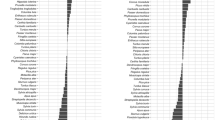Abstract
We study theoretically the effect of inter-habitat migration on the distribution of population sizes between two habitats, and compare this distribution with the expected ideal free distribution (IFD). Whenever emigration from the two habitats is asymmetric, or when there is a survival cost during migration, the resulting equilibrium distribution of population sizes deviates from the IFD. This result holds irrespective of emigration rule, even though a density-dependent fraction of emigrants generally produces a distribution closer to the IFD than a constant fraction of emigrants. Environmental stochasticity causes a linear relation between population sizes in the two habitats, with slope and intercept only identical to the IFD when net inter-habitat exchange is zero. The type and asymmetry of inter-habitat migration will influence how we should interpret data on population distribution in different habitats. The resulting resource matching is also critically contingent on the relative time-scales of population renewal and dispersal, and when population size is measured in relation to reproduction and dispersal. Therefore, data on population sizes cannot be used uncritically to assess habitat quality.
Similar content being viewed by others
References
Åstroöm, M., Lundberg, P. and Lundberg, S. (1996) Population dynamics with sequential density-dependencies. Oikos 75, 174–181.
Diaz, P.C. (1996) Sources and sinks in population biology. Trends Ecol. Evol. 1, 326–330.
Fretwell, S.D. and Lucas, H.L. (1970) On territorial behavior and other factors influencing habitat distribution in birds. I. Theoretical development. Acta Biotheor. 19, 16–36.
Hanski, I. and Gilpin, M.E. (eds) (1997) Metapopulation Biology: Ecology, Genetics and Evolution. Academic Press, San Diego.
Holt, R.D. (1985) Population dynamics in two-patch environments: Some anomalous consequences of an optimal habitat distribution. Theor. Popul. Biol. 28, 181–208.
Jonzén, N. and Lundberg, P. (1999) Temporally structured density-dependence and population management. Ann. Zool. Fenn. 36, 39–44.
Kennedy, M. and Gray, R.D. (1993) Can ecological theory predict the distribution of foraging animals? A critical analysis of experiments on the Ideal Free Distribution. Oikos 68, 158–166.
Lundberg, P. and Jonzén, N. (1999) Optimal population harvesting in a source-sink environment. Evolutionary Ecology Research 1, 719–729.
Morris, D.W. (1987) Tests of density-dependent habitat selection in a patchy environment. Ecol. Monogr. 57, 269–281.
Morris, D.W. (1991) Fitness and patch selection by white-footed mice. Am. Nat. 138, 702–716.
Pulliam, H.R. (1988) Sources, sinks and population regulation. Am. Nat. 132, 652–661.
Pulliam, H.R. and Danielson, B.J. (1991) Sources, sinks and habitat selection: A landscape perspective on population dynamics. Am. Nat. 137, 50–66.
Ranta, E., Lundberg, P. and Kaitala, V. (1999) Resource matching with limited knowledge. Oikos 86, 383–385.
Rozenzweig, M.L. (1991) Habitat selection and population interactions: The search for a mechanism. Am. Nat. 137, S5-S28.
Sæther, B-E., Engen, S. and Lande, R. (1999) Finite metapopulation models with density-dependent migration and stochastic local dynamics. Proc. R. Soc. Lond. B 266, 113–118.
Sutherland, W.J. (1996) From Individual Behaviour to Population Ecology. Oxford University Press, Oxford.
Tregenza, T. (1995) Building on the ideal free distribution. Adv. Ecol. Res. 26, 253–307.
Watkinson, A.R. and Sutherland, W.J. (1995) Sources, sinks and pseudosinks. J. Anim. Ecol. 64, 126–130.
Author information
Authors and Affiliations
Corresponding author
Rights and permissions
About this article
Cite this article
Palmqvist, E., Lundberg, P. & Jonzén, N. Linking Resource Matching and Dispersal. Evolutionary Ecology 14, 1–12 (2000). https://doi.org/10.1023/A:1011092401084
Issue Date:
DOI: https://doi.org/10.1023/A:1011092401084




